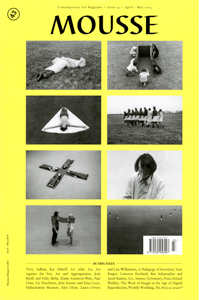Terry Adkins,
Kai Althoff, Art After Art, Art Against the Net, Art and
Appropriation, Josh Bitelli & Felix Melia, Elaine Cameron-Weir, Paul Chan, Liz Deschenes, João Enxuto & Erica Love, Hallucination Museum, Alex Olson,
Laura Owens & Lisa Williamson, A Pedagogy of Invention, Sean Raspet, Cameron Rowland, Ben Schumacher & Jared Madere, A.L. Steiner, Stylometry,
Franz Erhard Walther, The Work of Images in the Age of Digital Reproduction, Worldly Worlding,
The Artist as Curator insert (Avant-Garde Argentinian Visual Artists Group,
Tucumán Burn, 1968, by
Ana Longoni;
Liam Gillick &
Philippe Parreno,
The Trial of Pol Pot, 1998, by Dean Inskte).
The Artist as Curator is a serial publication examining the fundamental role artists have played as curators, from the postwar period to the present. In issue #2 Ana Longoni discusses the 1968 exhibition
Tucumán Burns, by the Avant-Garde Argentinian Visual Artists Group, while Dean Inskter's essay focusses on the 1998 show
The Trial of Pol Pot, by
Liam Gillick and
Philippe Parreno.
Nicolaus Schafhausen met with
Kai Althoff for a friendly conversation that touched on the theme of the influence of the artist's German background in his work, and experiences of the past, including his band Workshop.
Artists, writers, and bloggers struggle to overcome the web's imperative to brand and make work in accordance with the corporate gestures of "like" and "share." For Andrew Durbin, the art that counts is art that counters the network by exploiting the senselessness of "liking" each other, a gesture that reinforces the rule of a few quasi-monopolies.
In the first of a two-part series, John Menick investigates the field of stylometry—the computational study of writing style as a means of identifying authors. A science that has legal as well as academic and literary applications, ranging from the question of the authorship of Shakespeare's works to forensic linguistics.
Carolyn Christov-Bakargiev invites us to reflect on how the dissolution of the canonical sphere of art and its regrouping with other arenas of life and fields of knowledge could today offer an alternative to the process that has led to the exponential financialization and corporatization of the historically determined field of contemporary art.
Hans Ulrich Obrist met with German artist
Franz Erhard Walther, known for his radical reformulation of the relationship between art and action, done by transforming the body, space and time into materials of an original practice that powerfully engages the viewer in the guise of an artistic medium.
Chus Martínez talks about art practice, institutions and education in the years to come. Moving away from traditional alliances between arts and social sciences, she proposes concentrating on radical invention as the basis of a natural contract to position art beyond culture.
Apsara DiQuinzio met Paul Chan to talk about his upcoming show at the Schaulager—which will include the complete
Volumes work, "discussions" and "non-projections"—and about the artist's publishing house,
Badlands Unlimited, which releases "books in the expanded field."
What if art were no longer that radically creative sphere of endeavor we always imagined it to be?
Jens Hoffmann offers some fundamental reflections on the art of the last two decades, pointing out critical factors that have led much of art to neglect the need to be something more comprehensive and substantial than mere refined abstract exercise.
Nice to meet you: Cameron Rowland tells John Beeson how the "target hardening" process is a frame of reference for his work / Isla Leaver-Yap interviews Elaine Cameron-Weir to introduce us to her research on the sense of smell / Sean Raspet talks to Kevin McGarry about how he exploits the chemical makeup and poetic densities of substances.
João Enxuto and Erica Love weave a conversation with Sarah Hromack on the current and future roles of technology in institutional spaces. Their Art Project 2023 embodies the social anxieties prompted by technology in its narration of a speculative digital future for the Whitney Museum of American Art.
The museum is already compressed inside our smartphones. Museums operate as attractors of our attention, playing with competition in the realm of mass distractions. Joshua Decter focuses on aspects of interaction and suggests a fascinating next step, a museum-as-hallucination that will occupy one space only: the mind.
Charles Gaines offers a portrait of the late Terry Adkins, starting with his family and cultural background, and analyzing his production, which often fused and drew parallels between the synchronic language of the visual arts and the diachronic language of music.
Reporting from:
London: Lucia Pietroiusti sits down with Josh Bitelli & Felix Melia to talk about their investigations into physical labor, urban situations and sub-urban space.
Los Angeles: Like modern-day fauves ready to attack, the works of Lisa Williamson, Alex Olson and Laura Owens demand a bodily—more than a visual—reaction.
Andrew Berardini experiences them all in our stead, as it were...
New York: Artists Jared Madere and Ben Schumacher, moderated by Luke, the latter's writer brother, build a conversation around the human factor behind the work: the artist.
A.L. Steiner's creative practice is shaped, in turns, by an unwavering criticality of power systems and an ethics of generosity founded on principles of openness and personal communication. Chelsea Haines spoke with Steiner about the ideas and imperatives that permeate her work.
Photography and painting continue to revitalize histories of abstraction and collage, as these forms are being re-written by new tools. Lauren Cornell converses with artists Michele Abeles, Sara Cwynar, Jon Rafman and Travess Smalley regarding questions of appropriation.
Roxana Marcoci interviews Liz Deschenes, an artist whose work seems to imply a multiple timeframe of the moment, a "duration" that refers to history, reflects on the present, continues to unfold in time, and produces new forms of subjectivity.
Jennifer Allen continues to delve into the status of the image by returning to Walter Benjamin's definition of "sense of the universal equality of things," discovering its unexpected pertinence to digital reproducibility.


